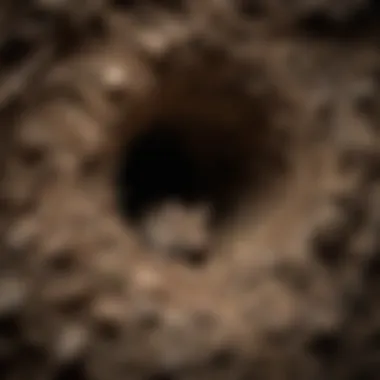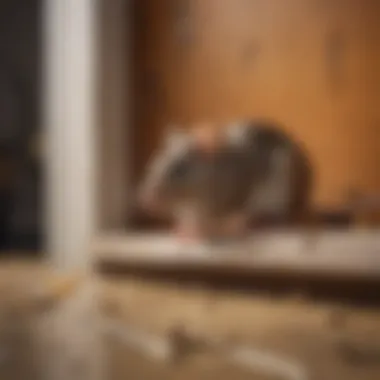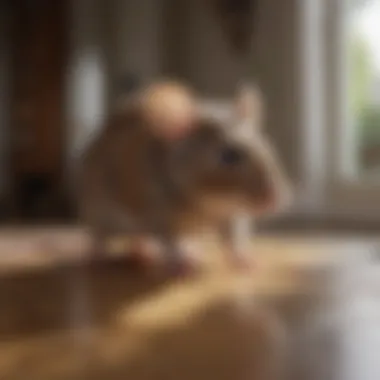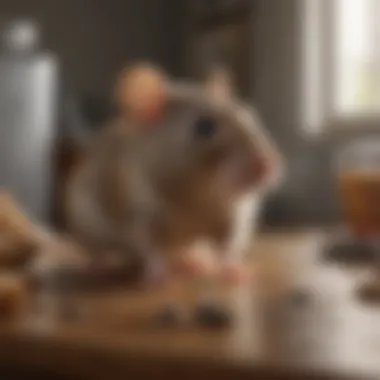Understanding Mice Mortality in Homes: Causes & Solutions


Intro
The presence of mice in a home often raises concerns for many homeowners. When it comes to understanding why these rodents may die within the walls and corners of a residence, several factors come into play. The phenomenon can be alarming and may pose health risks to the inhabitants. It is essential to explore not only the implications of dead rodents but also the reasons behind their unfortunate end within living spaces. This knowledge will enable homeowners and pest control professionals to develop strategies to manage and minimize these occurrences effectively.
Identification of Common Pests
Description of Common Pests
Mice are one of the most common household pests. The most prevalent species include the house mouse, deer mouse, and field mouse. House mice are small, typically grayish-brown, and measure around 2.5 to 4 inches in length, not including the tail. Deer mice are larger and have distinguishing white underbellies. Field mice also display a brownish hue, but they are known for living outdoors.
Mice are drawn to human habitats for food, water, and shelter. Their adaptability to various environments allows them to thrive in urban and suburban areas. The ability to reproduce rapidly means that a small mouse population can quickly escalate into a larger infestation.
Signs of Infestation
Recognizing the signs of a mouse infestation is crucial for timely intervention. Homeowners should look out for:
- Droppings: Small, dark droppings found near food sources or nests indicate active mice.
- Gnaw Marks: Chewed packaging or visible damage to cords and furniture can signal mouse activity.
- Nests: Often built from shredded paper or fabric, nests can be found in hidden places like cabinets or attics.
- Noises: Scratching or scurrying sounds, especially at night, may indicate that mice are present.
"Understanding the signs of an infestation can prevent larger problems down the line."
Prevention Techniques
Home Maintenance Tips
To minimize the risk of mice entering the home, proactive measures are essential. Regular maintenance is key. Start by sealing cracks and holes in the walls, foundation, and around windows. Use materials like steel wool or caulk to fill openings. Keeping food stored in airtight containers can deter mice; they are typically attracted to open food sources.
Moreover, keep the home tidy. Regularly clean up crumbs and spills, and do not leave pet food out overnight.
Environmental Modifications
Adjusting the surrounding environment can also reduce the likelihood of mice. Mice often enter homes seeking shelter. Therefore, it is useful to maintain landscaping by trimming bushes and removing debris from around the home. Ensure that trash bins are tightly secured and stored away from the house. These modifications create an inhospitable environment for rodents.
Eco-Friendly Pest Control Options
Natural Pesticides
For those seeking eco-friendly pest control solutions, natural pesticides can be a viable option. Essential oils, such as peppermint and eucalyptus, are known to repel mice. Spraying diluted essential oils around entry points can serve as a deterrent without the harmful effects of conventional pesticides.
Organic Pest Control Techniques
Employing organic methods to control mouse populations is vital for health-conscious homeowners. Traps can be utilized, specifically designed to capture rather than kill. Furthermore, introducing natural predators, like cats, is another ethical way to manage rodent populations. By utilizing these natural methods, homeowners can maintain a safe and environment-friendly household.
This expanded understanding of mice and their lifecycle provides a foundation for taking action. With informed precaustions and careful strategies, homeowners can manage pests effectively.
Prolusion to the Issue
Mice dying in houses presents a significant concern for homeowners and pest control professionals alike. Understanding the nuances of this issue is crucial because the presence of dead rodents can indicate broader problems that need addressing. Moreover, recognizing the factors that lead to rodent mortality is essential in managing both health risks and pest control effectively.
Defining the Problem of Mice in Houses
The problem of mice in houses extends beyond mere annoyance. Mice are known to consume food, damage property, and spread diseases. As they navigate through homes, they create nests, chew on wires, and often contaminate surfaces. This behavior can lead to severe repercussions for the inhabitants and requires immediate attention to resolve the situation.
Moreover, the issue escalates when these mice die within the home. The decomposition process can cause health hazards and unpleasant odors. These factors are vital for homeowners to consider because they influence both the efficacy of pest control strategies and the overall safety of the living environment.
Understanding Rodent Behavior
Mice are social creatures and have distinct patterns of behavior that influence their interactions with humans. They tend to thrive in environments where they find food, shelter, and companionship. Thus, understanding their habits is crucial. Mice often enter homes in search of warmth during colder months, or when food sources become scarce. They can squeeze through surprisingly small openings, making detection and prevention challenging. Their nocturnal nature means they are frequently active at night, which can also complicate awareness for homeowners.
Identifying behaviors that denote a mouse presence can be invaluable. For instance, look for signs such as gnaw marks, droppings, and nests. Awareness of these signs can enable timely interventions and possibly prevent the challenges that come with dead rodents in the home.


Importance of Pest Control
Effective pest control is paramount for various reasons. First, it ensures the health and safety of the occupants within the home. Mice are carriers of numerous diseases, including hantavirus and leptospirosis, which pose risks to human health. A proper pest control strategy reduces these risks significantly.
Additionally, proactive pest control can mitigate extensive property damage caused by infestations. Mice can gnaw on walls, insulation, and other materials, leading to expensive repairs.
Moreover, pest control should be conducted responsibly. Using options that are both effective and less hazardous to the environment ensures that infestations are dealt with in a sustainable manner. This balance makes pest control a critical aspect of home maintenance, benefiting both the household and the ecology.
Common Reasons for Mice Dying Indoors
Understanding the common reasons for mice dying indoors is crucial for homeowners and pest control professionals alike. This topic illuminates the various factors that can lead to rodent mortality in domestic spaces, revealing not only the interrelations among environments, health conditions, and pest control strategies but also providing actionable insights. Addressing the reasons behind mice deaths can lead to better management techniques, improving the living conditions and reducing health risks associated with rodent infestations.
Natural Causes and Lifespan
Mice generally have a short lifespan, living typically between two to three years depending on species and living conditions. Natural causes such as old age can lead to their demise. In many cases, a mouse may simply reach the end of its life cycle in an area where it feels secure, often hidden in walls or crawl spaces. Understanding this aspect is especially important for minimizing unnecessary interventions. Homeowners should discern whether the presence of dead mice is an indicator of a larger infestation or simply the result of natural life processes.
Disease and Health Factors
Like all living creatures, mice are vulnerable to various diseases. For instance, viruses and bacteria can significantly shorten their lives. Conditions such as respiratory infections and virus infections can lead to unexpected deaths. When mice die due to health complications, the implications extend beyond mere biology; understanding these factors helps homeowners assess possible health risks for humans as well. Specific diseases might suggest contamination or suggest a need for targeted interventions before a broader infestation occurs.
Toxicity from Pest Control Products
The use of pest control products is common, but it can also result in unintended consequences. Certain rodenticides, if not used properly, can cause severe toxicity, leading to a slow death for mice that consume them. Consequently, not only does this reflect on ethical pest management practices, but it also raises concerns about the safety and comfort of living spaces. Homeowners must be aware of how their pest control methods may impact not only the target species but also non-target species, including pets and humans. A thorough understanding of the types of products used can help ensure responsible pest management.
Starvation and Dehydration
Mice are also prone to starvation and dehydration, particularly when food sources are scarce. During certain seasons or periods of drought, it becomes challenging for them to find adequate nutrition and hydration. This aspect often goes unnoticed until mice start to perish within homes. Awareness of seasonal patterns in rodent behavior can aid homeowners in taking preventive action. Ensuring ample food sources are not inadvertently available helps in managing the population effectively and reduces the likelihood of finding dead rodents indoors.
Health Implications of Dead Rodents
Understanding the health implications of dead rodents is critical for homeowners. When a mouse dies indoors, it can pose several risks to human health and property. This section covers key aspects related to the possible diseases, decomposition effects, and the attraction of other pests which may follow. Knowing these implications enables individuals to address the issue effectively and protect their living environment.
Rabies and Other Diseases
While the chances of contracting rabies from a dead mouse are low, the presence of dead rodents can facilitate the spread of various diseases. Mice are known carriers of pathogens that can be harmful to humans. Hantavirus, for instance, can be transmitted through contact with mouse droppings, urine, or saliva. Moreover, leptospirosis is another disease associated with rodents, potentially leading to severe health issues if not treated.
Some common diseases linked to mice include:
- Salmonellosis: This bacterial infection can arise from consuming food contaminated by mouse feces.
- Lymphocytic Choriomeningitis (LCMV): A viral infection that can cause severe illness, affecting the nervous system.
The key takeaway is that homeowners should treat the discovery of a dead mouse with caution. Protective gear, such as gloves and masks, is essential when handling such cases, to prevent infections.
Decomposition and Odor Issues
Dead rodents can quickly decompose, leading to considerable odor problems. The process of decomposition can produce foul smells that permeate the living space. It can also attract insects and other scavengers, complicating pest control efforts.
Factors that influence decomposition include:
- Temperature: Warmer temperatures accelerate decay.
- Moisture: Damp environments can speed up decomposition.
To manage odor issues, it is crucial to locate and properly dispose of deceased mice. Thorough cleaning of the area ensures a reduction in health risks and contributes to a more pleasant living environment.
Attraction of Other Pests
Another significant health implication associated with dead rodents is the potential attraction of other pests. When mice die, they can be a food source for more than just scavengers. Insects like flies, particularly houseflies, are often drawn to decaying matter, potentially laying eggs in or around the carcass. This may lead to further infestations.
In addition, ants and other rodents like rats might be attracted to the scent of decay. Such infestations can exacerbate the existing rodent problem or introduce new pests into the household, complicating management efforts.
In summary, the health implications of dead rodents extend beyond immediate concern. Addressing these factors promptly is key to maintaining a healthy living environment and preventing related issues.


Identifying the Signs of Mouse Infestation
Understanding the signs of a mouse infestation is vital for homeowners. Identifying these signs early can help prevent more significant issues, such as disease transmission and property damage. Mice can quickly multiply and establish a presence in your home. Therefore, recognizing the indicators of mice can be a significant step toward effective pest control.
Visual Cues of Entry Points
Mice are excellent at finding small openings to enter homes. They can squeeze through holes as tiny as a pencil eraser. Look for signs around the foundation, walls, or openings around doors and windows. Inspect areas like:
- Basements: Often have gaps that are not secure.
- Crawl spaces: May have more substantial openings due to poor maintenance.
- Attics: Vents or openings that are not screened can be pathways.
Pay attention to any gnaw marks around these entry points. Mice will chew through materials to get inside. If you notice signs of gnawing, it may indicate they are attempting to gain access.
Common Signs of Activity
Once mice have made their way in, their activities will leave traces. Common indicators include:
- Droppings: Tiny, dark pellets found in areas where you see food or nesting materials. They resemble grains of rice and can be found near food sources or hiding spots.
- Nests: Mice build nests from shredded paper, fabric, and other materials, often in hidden spots like behind appliances.
- Footprints or Runs: Dusty areas may reveal footprints. You may also observe smudge marks along walls where mice frequently scurry.
Detecting these signs early can aid in preventive measures before an infestation grows.
Using Traps for Monitoring
Employing traps can help you gauge mouse activity in your home. Several types of traps exist, including snap traps, glue traps, and humane traps. Consider the following when using traps:
- Placement: Set traps along walls where rodents are likely to travel. Mice tend to run along edges rather than crossing open spaces.
- Bait: Use appealing bait like peanut butter or sunflower seeds to attract mice. Place bait inside or near the traps to increase effectiveness.
- Monitoring: Check traps regularly. This not only ensures immediate action but can provide insights into the level of infestation.
Using traps will provide both information on the activity and can help to reduce the mouse population in your home.
Identifying signs early is the key to preventing a larger infestation. Maintain vigilance and address any discoveries swiftly.
Effective Pest Control Strategies
Effective pest control strategies are crucial in managing the issue of mice dying in your home. They not only help in preventing infestations but also protect your living environment from the potential risks associated with rodent-related health issues. Implementing efficient control measures can significantly reduce the likelihood of encountering dead rodents and the subsequent health hazards that may arise. Focusing on preventive tactics, humane trapping, and responsible use of baits and poisons forms the backbone of a comprehensive pest management plan.
Preventive Measures
Sealing Entry Points
Sealing entry points is a foundational aspect of preventing mice from entering your home. Mice can squeeze through small gaps, making it essential to inspect and secure potential entryways. The key characteristic of this approach is its proactive nature; by sealing off access routes before any infestation occurs, homeowners can reduce the risk significantly.
A unique feature of sealing entry points is that it can often be done using readily available materials like caulk or steel wool. This method is advantageous because it is generally low-cost and easy to implement. However, it can be time-consuming if your home has numerous vulnerabilities to address.
Proper Waste Management
Proper waste management is another important strategy to deter mice from entering your house. Mice are often attracted to easily accessible food and garbage. By implementing good waste disposal practices, you can reduce the likelihood of attracting these pests.
The key characteristic of proper waste management is the systematic approach to keeping food waste contained and secure. Proper disposal practices create a less appealing environment for mice, making your home less inviting to them. Storing trash in sealed containers and disposing of it regularly are effective measures. The unique feature of this strategy lies in its dual benefit: not only does it prevent rodent attraction, but it also contributes to overall household cleanliness. However, enforcing this practice consistently is necessary to see lasting results.
Maintaining Clean Spaces
Maintaining clean spaces is vital in any effective pest control strategy. A clean house minimizes the habitats where mice can thrive. The key characteristic of this method is the routine cleaning and decluttering of areas where mice might hide or nest, such as under appliances or in basements.
The unique feature of maintaining cleanliness is the assurance that mice will find fewer places to occupy, which acts as a natural deterrent. Regular vacuuming, wiping surfaces, and removing clutter are essential tasks in this process. While this method is highly beneficial, it requires a commitment to regular upkeep.
Humane Trapping Methods
Humane trapping is a preferred choice for many homeowners concerned about animal welfare. This method involves using traps designed to capture mice without harming them. Various types of humane traps are available, typically using bait to lure the mice inside, where they can be safely transported and released elsewhere. The appeal of these traps lies in their ability to address the problem without resorting to lethal methods.
Adopting such traps requires understanding the proper placement for optimal effectiveness. Users should regularly check traps to ensure captured mice are released in a timely manner. This approach can be more challenging, as it requires consistent monitoring and care from the homeowner.


Using Baits and Poisons Responsibly
Using baits and poisons can be effective for severe infestations but necessitates careful handling. The importance of choosing the right products and applying them responsibly cannot be overstated. This method can control mouse populations effectively but may also pose risks to pets and non-target wildlife if not used correctly.
Homeowners must ensure that these products are placed in secured locations away from children and pets to avoid accidental ingestion. It is vital to follow all manufacturer's instructions to minimize risks. The advantage of this strategy is its efficacy in rapid population control, which is particularly helpful when facing major infestations.
"Preventive measures are your first line of defense against mouse infestations."
By integrating these strategies into a comprehensive pest control plan, homeowners can effectively reduce the risks associated with rodent populations in their homes.
When to Seek Professional Help
Understanding when to ask for professional pest control services is vital. While some homeowners might believe they can handle minor mouse issues on their own, certain signs indicate a larger problem requiring expert intervention. Delaying professional assistance might lead to health risks, structural damage, and increased costs. Knowing the right time to seek help can save both time and resources, ensuring a more effective resolution.
Signs Indicating a Major Infestation
There are specific indicators that signal a serious mouse infestation. Recognizing these signs early can make a significant difference in preventing further damage. Here are some common signs to look out for:
- Presence of droppings: Mice leave behind droppings, especially near food sources or nesting sites.
- Nests and burrows: Mice often create nests using shredded materials; spotting these can indicate their presence.
- Strange sounds: Noises in walls or ceilings at night may suggest mice scurrying about.
- Damage to food and packaging: If food items appear gnawed or compromised, it may be a sign of mice.
- Referral from neighbors: If neighbors report similar issues, it is wise to consider your home may be affected.
Observing these signs should prompt immediate action. A professional pest control service will assess the situation and create a targeted approach for resolution.
Choosing a Pest Control Service
Selecting the right pest control service is crucial for effective mouse elimination. Not all services offer the same quality or approach to pest management. Here are some tips to help in the decision-making process:
- Research: Look for local pest control businesses. Check reviews on websites like Reddit or Facebook to gauge customer satisfaction.
- Certifications: Ensure that the company has qualified technicians. Certifications often reflect the level of expertise.
- Methods Used: Inquire about methods being used, especially regarding environmental impact. Emphasizing integrated pest management techniques ensures responsible practices.
- Cost Estimates: Obtain estimates from multiple services but focus on value rather than just cost. Cheaper options may lack thoroughness.
- Follow-Up Services: Good pest control services have follow-up procedures to ensure the problem is completely resolved.
Choosing the right expert service can be a game changer in eliminating the problem. Taking the time to assess options ensures homeowners receive effective solutions tailored to their situation.
Legal and Environmental Considerations
Understanding the legal and environmental considerations regarding rodent control is essential. Homeowners often overlook the implications of pest management efforts, potentially leading to legal consequences or adverse ecological effects. This section aims to guide individuals through these elements, ensuring responsible practices in addressing mouse infestations.
Regulations on Rodent Control
Rodent control is regulated by various local and national laws. Many jurisdictions impose strict guidelines on the methods employed to control rodent populations. Failure to adhere to these regulations can result in fines or legal action.
Some key regulations include:
- Use of Chemicals: Many areas restrict the use of specific rodenticides due to their toxicity. These rules aim to prevent harm to non-target wildlife and humans.
- Disposal of Carcasses: Local laws may dictate how to safely dispose of dead rodents, emphasizing environmental health and hygiene.
- License Requirements: In some regions, pest control services must be licensed to ensure compliance with safety and effectiveness standards.
Homeowners should familiarize themselves with applicable laws to avoid unintentional violations. Consulting local regulations or a pest control expert can provide clarity on what practices are acceptable.
Ecological Impact of Rodent Control Methods
The ecological impact of how homeowners manage rodent infestations can be significant. With the application of certain pest control methods, unintended consequences may arise that affect local ecosystems.
Beware of the following ecological considerations:
- Secondary Poisoning: The use of poisons can lead to unintended harm to non-target species, such as birds of prey or pets, which may consume poisoned rodents.
- Biodiversity Threats: Intensive rodent control can disrupt the food chain, creating imbalances that may harm various species within an ecosystem.
- Chemical Residues: Certain pest control products can contaminate soil and water systems, posing risks to plants and animals.
Adopting environmentally friendly pest management practices is beneficial. Solutions such as traps, natural repellents, or integrated pest management can reduce negative ecological footprints while effectively managing rodent populations.
It’s crucial for homeowners to understand that responsible pest control should always consider the legal framework and the broader impact on our environment.
By recognizing and respecting these legal and ecological aspects, homeowners can engage in pest management strategies that protect both their homes and the environment.
Closure
Summarizing the Key Points
To recap, the article delves into the reasons behind rodent deaths and the significance of taking precautionary measures. Some key points include:
- Common causes of mice dying indoors, including health issues and exposure to toxins.
- The health implications associated with decomposing mice and disease transmission.
- Effective pest control strategies to prevent infestations and decrease the chances of mouse deaths.
Importance of Ongoing Control Efforts
Ongoing pest control is essential for maintaining a safe living environment. Rodents can reproduce rapidly, making regular inspections and preventive measures crucial. Continued vigilance also reduces the chances that dead rodents will pose health threats.
In summary, tackling the issue of mice mortality in homes is not just about managing current infestations. It also promotes a healthier, safer environment for everyone. Addressing both prevention and control leads to lasting solutions that ultimately benefit homeowners.







